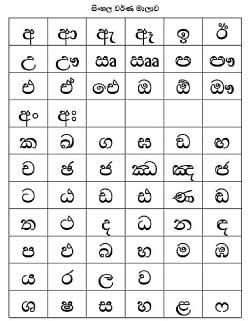Reply To:
Name - Reply Comment
When I cannot see words curling like rings of smoke round me I am in darkness -- I am nothing -- Virginia Woolf in The Waves.
Supposedly the language spoken by nearly 16 million Sri Lankans, Sinhala does not fall into the category of the world’s most endangered languages. Still, being geographically limited to the island nation of Sri Lanka, the Sinhala language, unlike its sibling Tamil, runs the risk of being disappeared faster than many smaller languages with greater geographical spread.
With the gradual upgrading of English from the second language to main spoken language at urban homes of young parents and the English medium education once again becoming a norm than a fad, Sinhala is being pushed to the back yard slowly yet steadily.
What disappears with this gradual downgrade of the mother tongue is its cultural element. A language is the thread that runs through civilization and Sinhala being the language for more than two and-a-half millennia of this country the fading away of it also mark the death of its culture with its ethos and memories.
 While change is a perennial factor in any organic society what is sad however is the total inadequacy of the attention paid to the decline in the usage of Sinhala, especially given the fact that it is one of the most cutting edge languages in today’s world.
While change is a perennial factor in any organic society what is sad however is the total inadequacy of the attention paid to the decline in the usage of Sinhala, especially given the fact that it is one of the most cutting edge languages in today’s world.
With an advanced grammar system, Sinhala, according to linguists, is way ahead of most of the widely spoken languages in the world today including Spanish, Portuguese, French and Italian - the so-called Romance languages or the ‘corrupt’ versions of the Latin language.
Belonging to the Indo-Aryan group of the Indo-European languages which has Bengali, Gujarati, Punjabi and Marathi among others in the cluster, the Sinhala language hardly has a rival when it comes to phonetics and syntax even in this group.
Though initially it had quite a few affinities with Bengali, largely due to mass migration movement from the region to Sri Lanka from third century BC onwards, the Sinhala vocabulary has later evolved to be substantially influenced by the Gujarati language.
Right now Sinhala shares hundreds of words with Gujarati, the Indian language to be most influenced by the Persian vocabulary due to its geographical proximity and trade. It is also believed regular trade, scholarship and many other factors have contributed to Sinhala being influenced by Gujarati other than both being advanced offshoots of Sanskrit language. With nearly 60 million speakers, Gujarati is believed 26th most widely spoken language in the world today and the 6th among the Indian languages.
Nearly half of the 7,000 or so languages used in today’s world are slated to disappear within the next three generations or so, and it is said close to 300 languages have already died since World War II. Sinhala is not only a language of the Sinhalese but also the story of the people of this land. Other than Bengali and Gujarati, today it is sprinkled with words from Tamil, Arabic, Portuguese, Dutch, English and many other languages.
Despite its surface hybridization due to island factor, it has managed to preserve its strong unique features to-date, thanks to the hard work of the scholars comprising both the clergy and the laity. However, unless there is due patronage from the State to preserve and propagate the language, it is very likely to be among the ones to be disappeared in the next 50 years or so.